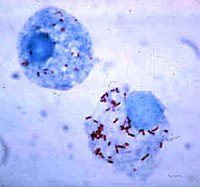
Photo from wikipedia
Rickettsia rickettsii - the etiologic agent of Rocky Mountain spotted fever (RMSF) - is widely spread across the Americas. In the US, Dermacentor spp. ticks are identified as primary vectors… Click to show full abstract
Rickettsia rickettsii - the etiologic agent of Rocky Mountain spotted fever (RMSF) - is widely spread across the Americas. In the US, Dermacentor spp. ticks are identified as primary vectors of R. rickettsii and Rhipicephalus sanguineus s.l. has been implicated in transmission of this pathogen in several locations in the Southwest. Conversely, ticks of the genus Amblyomma are recognized vectors of RMSF in Central and South America, but not in the US. A. americanum is one of the most aggressive human-biting ticks in the US, whose geographical range overlaps with that of reported RMSF cases. Despite sporadic findings of R. rickettsii DNA in field-collected A. americanum and circumstantial association of this species with human RMSF cases, its vector competence for R. rickettsii has not been appropriately studied. Therefore, we assessed the ability of A. americanum to acquire and transmit two geographically distant isolates of R. rickettsii. The Di-6 isolate of R. rickettsii used in this study originated in Virginia and the AZ-3 isolate originated in Arizona. Under laboratory conditions, A. americanum demonstrated vector competence for both isolates, although the efficiency of acquisition and transovarial transmission was higher for Di-6 than for AZ-3 isolate. Uninfected larvae acquired the pathogen from systemically infected guinea pigs, as well as while feeding side by side with Rickettsia-infected ticks on non-rickettsiemic hosts. Once acquired, R. rickettsii was successfully maintained through the tick molting process and transmitted to susceptible animals during subsequent feedings. Guinea pigs and dogs infested with infected A. americanum developed fever, scrotal edema and dermatitis or macular rash. R. rickettsii DNA was identified in animal blood, skin, and internal organs. The prevalence of infection within tick cohorts gradually increased due to side-by-side feeding of infected and uninfected individuals from 33 to 49% in freshly molted nymphs to 71-98% in engorged females. Moreover, R. rickettsii was transmitted transovarially by approximately 28% and 14% of females infected with Di-6 and AZ-3 isolates, respectively. Hence, A. americanum is capable of acquiring, maintaining and transmitting R. rickettsii isolates originating from two different geographical regions of the US, at least under laboratory conditions. Its role in ecology and epidemiology of RMSF in the US deserves further investigation.
Journal Title: Ticks and tick-borne diseases
Year Published: 2017
Link to full text (if available)
Share on Social Media: Sign Up to like & get
recommendations!